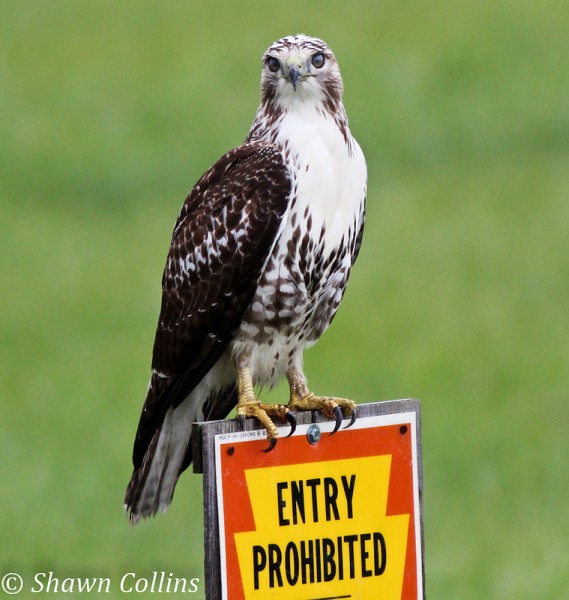
“No. You can’t come near me.”
(Immature red-tailed hawk, perched on the boundary of a State Gameland Propagation Area; photo by Shawn Collins)

“No. You can’t come near me.”
(Immature red-tailed hawk, perched on the boundary of a State Gameland Propagation Area; photo by Shawn Collins)
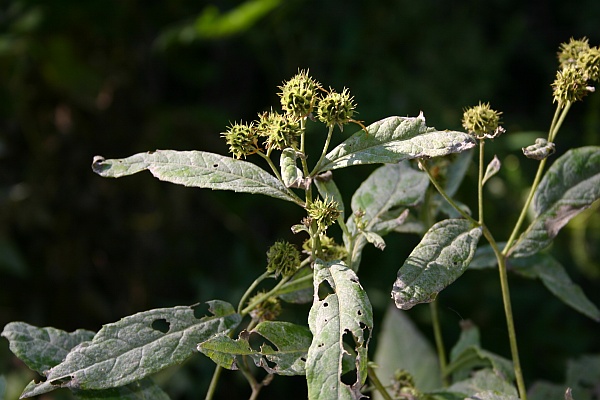
Sometimes seed pods are just as interesting as the flowers that produce them.
These many-faceted globes are Wingstem (Verbesina alternifolia) gone to seed.
(photo by Kate St. John)
This month the Arctic sea ice melted to its smallest extent since satellite monitoring began. To see the dramatic change in only 33 years, click here and drag your mouse over the map.
We are used to hearing that the ice has melted, but the surprise this year is that no one thought it would happen this fast. Scientists thought the ice was thick and needed real warmth to melt. The models said it would take years to get this bad.
Apparently not. Apparently the ice is so thin that a strong wind can break it into slush that melts quickly.
And there was a strong wind.
The NASA animation above shows arctic wind circulation from August 1 to September 13. The long red arrows are the fastest winds.
Play the video and you’ll see a storm blow off the coast of Alaska on August 5 and swirl into a cyclone that broke up the ice and opened a large extent of the ocean.
This dramatic melting creates a gigantic feedback loop in which the lack of ice causes temperatures to rise and that causes more ice to melt.
A churning cyclone. A feedback loop. The situation is changing rapidly and brings to mind this verse:
Turning and turning in the widening gyre
The falcon cannot hear the falconer;
Things fall apart; the centre cannot hold;
Mere anarchy is loosed upon the world…”
— from The Second Coming by William Butler Yeats
(video from NASA/Goddard Space Flight Center Scientific Visualization Studio)
There are plenty of birding opportunities in the month of October. Here are a few that came across my desk in the last week.
Hawk Watch:
October is a great time to watch hawks, falcons and eagles on their southward journey. Click on the embedded links for details:
Three Rivers Birding Club holds outings almost every week. Summarized below are the outings through October. Click here for September details and here for October’s information.
Saturday, September 29 – Harrison Hills Park – leader: Jim Valimont, 8:15 AM
Saturday, October 6 – Presque Isle – leader: Shawn Collins, 9:00 AM
Sunday, October 7 – Frick Park – leaders: Jack and Sue Solomon, 7:30am
Saturday, October 13 – Pymatuning Area – leader: Bob VanNewkirk, 9:00 AM
Sunday October 28 – Moraine State Park – annual Three Rivers Birding Club picnic and bird walk, 8:00 AM.
The Audubon Society of Western Pennsylvania holds outings at their three locations: Beechwood Farms Nature Center, Todd Sanctuary and Succop in Butler, Pennsylvania. I’ve summarized the birding activities below but be sure to follow this link to the calendar and sign up online:
Friday, September 28 – Discovery Morning Walk at Todd Sanctuary
Wednesday, October 3, 9:00am – RADical Days Senior Hike at Beechwood
Wednesdays in October 10 through 31, 9:00am – Discovery Morning Walk at Beechwood
Thursdays in October 11 through 25, 9:00am – Discovery Morning Walk at Succop, Butler, PA
Pleasant Hills Arboretum Fall Bird Walks:
Bob Mulvihill will lead a series of bird walks at Pleasant Hills Arboretum on Saturdays: September 29, October 13, and October 20. Meet at the Arboretum parking lot on West Bruceton Road at 8:00am. Walks will last one to two hours. Bring binoculars if you have them. All ages and skill levels are welcome.
Grab your binoculars. See some birds. 🙂
(photo from Wikimedia Commons. Click on the image to see the original)
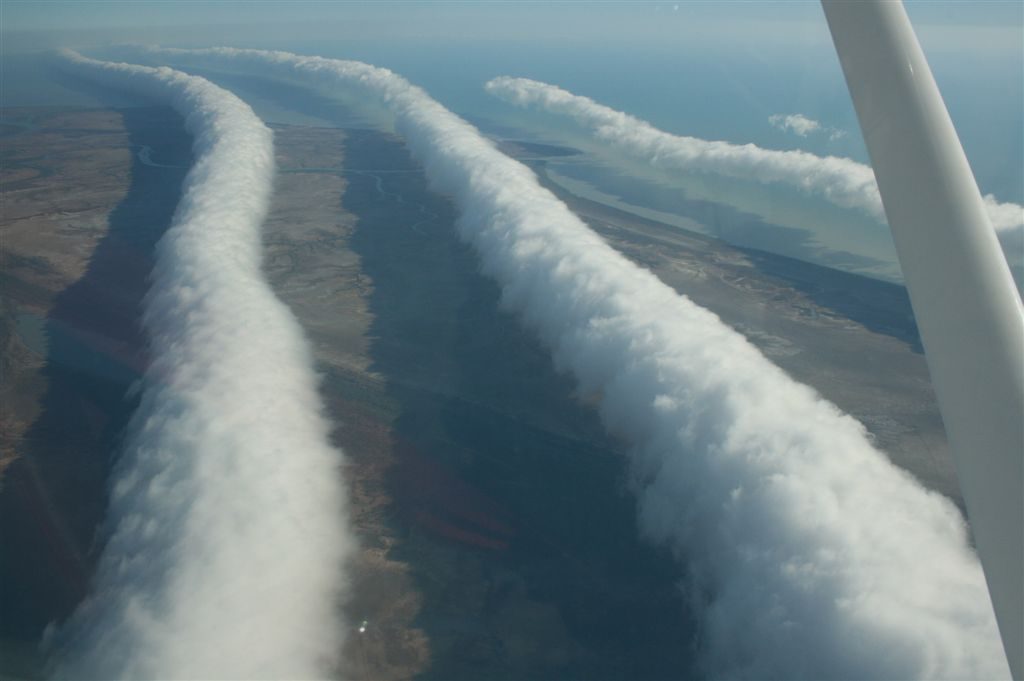
A morning glory is a flower, right?
Yes, and it’s also the name of these very rare roll clouds that stretch as much as 1000 km. That’s 620 miles, the distance from Pittsburgh to Dallas, Texas!
I’ve never seen a morning glory cloud but the literature says they are low and tubular and appear to be rolling on their horizontal axis. They travel up to 60 kilometers per hour (37 mph) over a landscape that has no wind at ground level — until they arrive.
Morning glories bring wind with them and such great updrafts on the leading edge that glider pilots flock to the only place on earth where these clouds reliably occur: northern Australia’s Gulf of Carpentaria from August to November. Some have ridden these clouds for 500 km (310 mi).
Morning glory clouds can form (rarely) in response to severe thunderstorms but in Queensland they’re caused by sea breezes that flow onshore overnight at the Cape York Peninsula. The moist air comes from both east and west, meets in the middle over the peninsula, and rises into a stack of cold, turbulent air. Before dawn the stack is blown westward over the Gulf and causes ripples in the sky, each one carrying a long roll cloud.
Right now it’s spring in Australia and prime season for this rare phenomenon. In Burketown, Queensland the glider pilots awake before dawn, hoping for glory.
(photo by Mick Petroff via Wikimedia Commons. Click on the image to see the original)
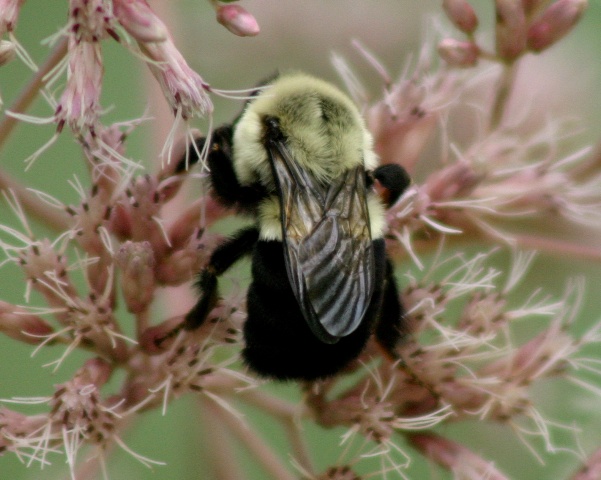
Did you know that bumblebees purposely vibrate flowers to release their pollen?
Bumblebees collect both nectar and pollen to feed their young. For the most part they travel from flower to flower and quickly gather what they need, but when a good food source is uncooperative they may resort to force.
When the flower entrance is nearly sealed, as in closed gentians, the bumblebee forces her way in.
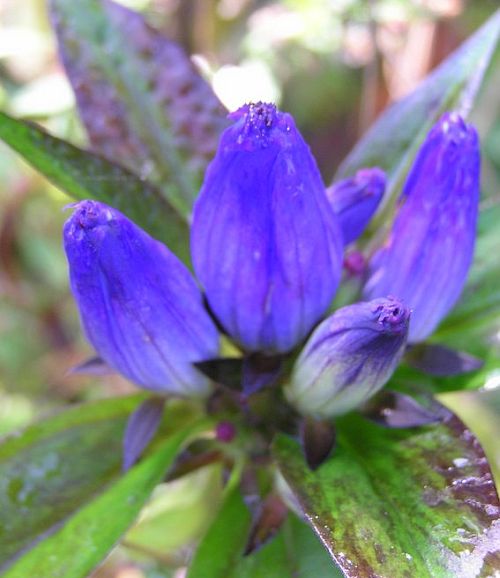
When the flower’s anthers won’t release pollen, the bumblebee shakes them. She does this by grabbing hold of the flower and vibrating her flight muscles — that’s what makes her buzz — so the technique is called buzz pollination.
A small percentage of plants must be shaken to release pollen but others benefit from it including shooting stars (Dodecatheon) and the Solanum genus: tomatoes, potatoes and eggplant.
Thus, bumblebees are often hired to pollinate greenhouse tomatoes.
Grab hold and shake!
(photo by Chuck Tague)
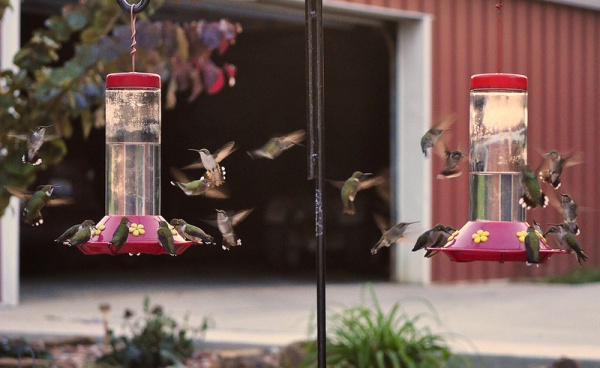
Last week Peter Bell alerted me to this awesome photo of more than two dozen ruby-throated hummingbirds. Taken on September 18 by Illinois photographer jeffreyw, the feeders are mobbed by tiny birds. Jeffrey aptly calls this, “Please take a number.”
If you feed hummingbirds, I’m sure you find this scene as amazing as I do. Normally a single hummer dominates the feeder and chases all others away. Who knew that when large numbers feed together they line up peacefully!
See how nicely they’re behaving?
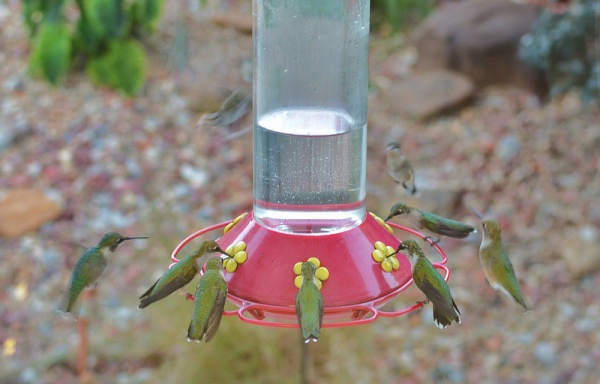
And here’s a quick video of Jeffrey’s feeders in mid-August. You can hear them chirping. Wow!
I asked Jeffrey how he attracts so many hummingbirds.
He wrote, “We mount feeders according to demand, one early [in the season], then adding until we get to 5 feeders. We could add more but have restricted ourselves lest the project gets out of hand. As the birds migrate away we remove feeders until we are back to one and leave that one till the freeze.
We have been building our flock for 25+ years.”
Persistence pays off. Feed them (a lot!) year after year, and they will come.
Thanks to JeffreyW for permission to use his photos. Hummingbirds aren’t his only subject. Check out his photos and food on the What’s 4 Dinner Solutions blog.
(photos and video by jeffreyw)
p.s. Very soon all the ruby-throats will have left the eastern U.S. for their winter home. If you’re addicted to hummingbirds and up for a challenge, leave your feeder out, keep it from freezing, and you just might attract a Selasphorus (rufous or Allen’s) hummingbird newly arrived from western North America. Here’s Scott Weidensaul’s advice on how to attract these unusual western hummingbirds and Rob Protz’ history of rufous hummers in Pennsylvania.
Here’s a beautiful bird called a red-headed finch (Amadina erythrocephala).
Because of their beauty they’re sometimes kept as pets but this is a wild one, photographed at Sossusvlei in the Namibian desert.
Though his range is slated to decrease as Earth’s climate becomes hotter, it looks as if he will still occur here in 2085.
(photo by Hans Hillewaert, Picture of the Day 27 Feb 2008 at Wikimedia Commons)
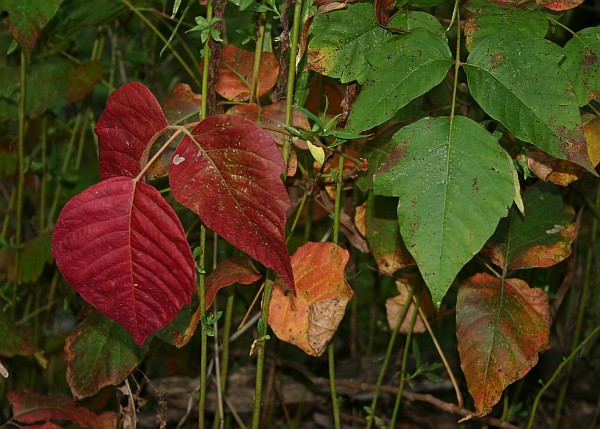
Are you collecting fall foliage to dress up a flower arrangement?
Don’t touch this plant!
Poison ivy is putting on quite a show as it turns beautiful shades of red and orange that highlight its white berries. Birds love the berries but most humans develop a rash — or worse — from touching the plant.
If you’re not sure how to identify poison ivy, click here for the clues that will spare you an itchy experience.
Leaves of three, let them be! … even when they’re red.
(photo of poison ivy in Schenley Park this week, by Kate St. John)
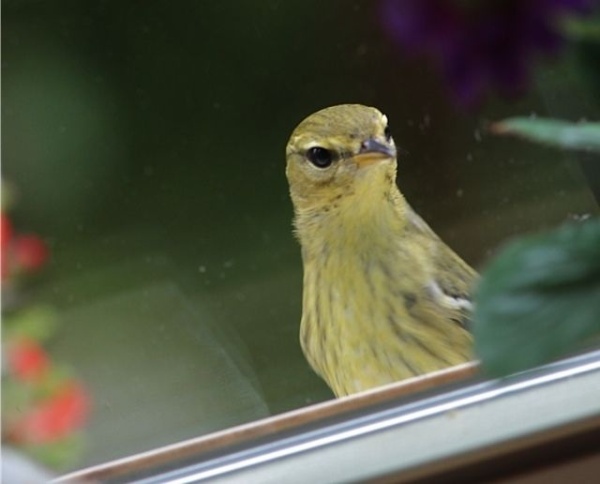
In Peterson’s Eastern Field Guide To The Birds there are four pages labeled “Confusing Fall Warblers.”
For years I avoided those pages. The birds on them are too similar to each other and so different from their spring counterparts that they may as well be new species.
But you can’t avoid them. Confusing fall warblers do show up at this time of year.
On Tuesday this confuser visited Marcy Cunkelman’s windowsill. It’s a blackpoll warbler. I’m guessing it’s female.
She looks nothing like a springtime male (left) who has crisp black and white feathers, an all-black cap, a white breast and bright yellow legs and feet. This bird is greenish yellow and stripe-y (right).
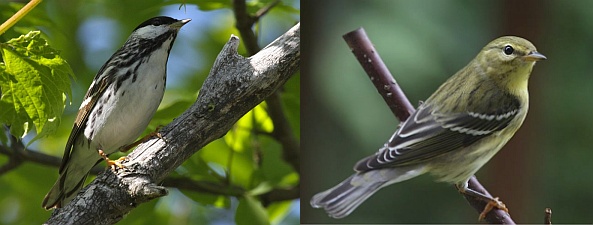
But to me, she fairly shouts blackpoll because:
Fall blackpolls resemble fall bay-breasted warblers, except that fall bay-breasted’s aren’t stripe-y and they usually have a faint pink wash on their sides. Click these links for views of spring bay-breasted and fall bay-breasted warblers. The spring birds look nothing like blackpolls!
Here are two more of Marcy’s photos to show off this blackpoll’s features.
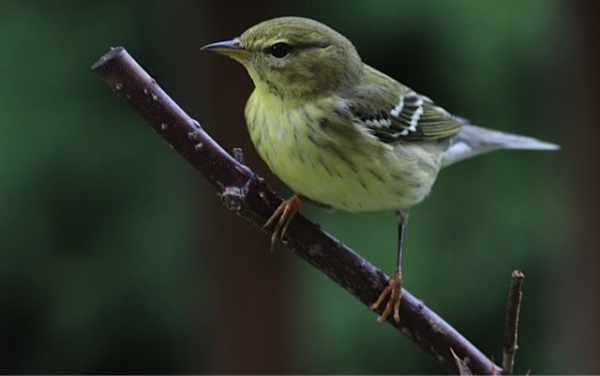
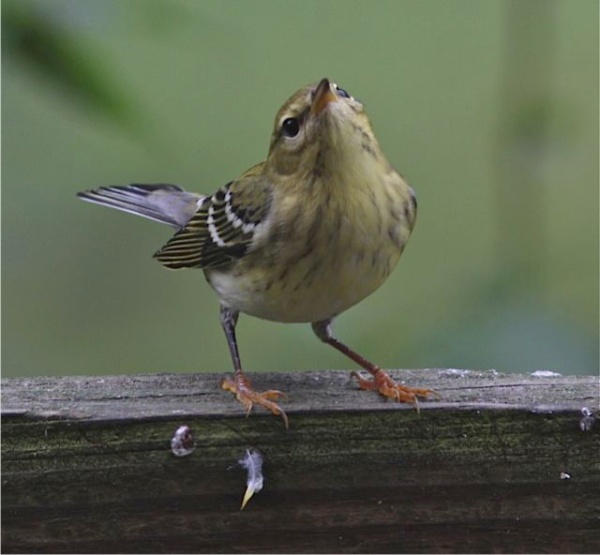
Notice how she has dark legs and orange feet. The field guides say her legs should be light-colored too but her two-tones are very cool. They remind me of snowy egrets’ black legs and fancy yellow feet.
So.. my best tip on identifying this confusing fall blackpoll is: Stripes and feet.
(fall blackpoll photos by Marcy Cunkelman, spring blackpoll by Chuck Tague)
p.s. Her beak is two-toned, too. What a cool bird!